Institute of Egyptian Art & Archaeology
Thebes - Temple of Hatshepsut
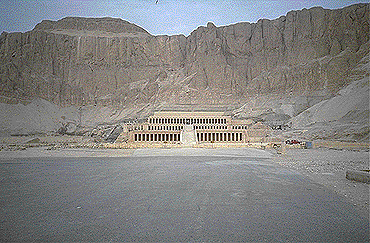
Mortuary Temple of Queen Hatshepsut
The mortuary temple of Hatshepsut (c.1478/72-1458 B.C.E.) dates from the New Kingdom. It nestles at the foot of the cliffs in a natural "bay" on the West Bank of Luxor. This area had long been sacred to the goddess Hathor and was the site of the earlier mortuary temple and tomb of King Nebhepetre Mentuhotep (c.2008-1957 B.C.E.) of the Middle Kingdom (ramp visible on the far left). After the introduction of Christianity, Hatshepsut’s temple was used as a monastery, hence its modern name, Deir el-Bahri, Arabic for "Northern Monastery."
Hatshepsut was a female pharaoh who had herself represented pictorially as a male. She served as co-regent with her nephew Thutmose III (c.1479-1425 B.C.E.).
The Polish National Academy of Sciences is responsible for the study and restoration of the three levels of the temple. As of spring 1995, the first two levels were almost complete, and the top level was still under reconstruction.
Hatshepsut’s temple was well situated to escape rock slides, unlike the temples of Nebhepetre-Mentuhotep and Thutmose III (to the left and behind Hatshepsut’s Temple).
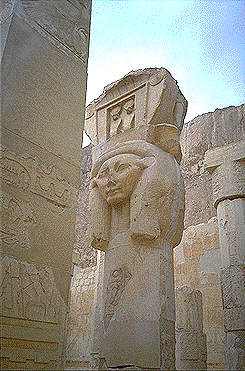
Temple of Hatshepsut - Hathor Chapel
Since Hathor was the guardian of the Deir el-Bahri area, it is appropriate to find a chapel dedicated to her within Hatshepsut’s mortuary temple (south end of second level). The columns which fill the court of this chapel have Hathor columns, each of which resemble a sistrum, a percussion instrument associated with the goddess of love and music. The capital is a female head with cow ears topped with a crown, the curved sides ending in spirals, perhaps suggestive of cow horns. The central section of the crown is a shrine in which two uraei (rearing cobras with spread hoods) are surmounted by sun disks. A cavetto cornice tops the whole.
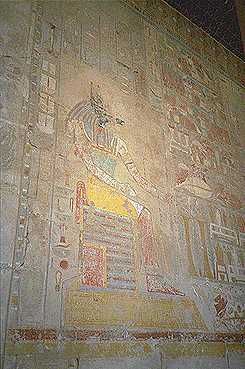
Temple of Hatshepsut - Anubis Chapel
At the north end of the second level of Hatshepsut’s mortuary temple, is the Anubis Chapel. Anubis was the god of embalming and the cemetery. He was frequently represented with the body of a man and the head of a jackal, as he is shown here. Anubis sits on a throne, which, in turn, rests on a small plinth. He faces a pile of offerings which reaches in eight levels from the bottom to the top of the register.
Although much of the color is now gone, one can imagine the vibrancy of the original painting. The Egyptians used mineral pigments; so the colors have not faded as much as vegetable pigments would have.
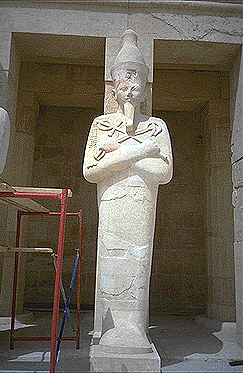
Temple of Hatshepsut - Osiride Statue
This Osiride statue stands in front of one of the columns on the third level of Hatshepsut's mortuary temple. Osiris was the Egyptian god of fertility, resurrection, and the next world. He was usually pictured wrapped as a mummy, holding a crook and flail as scepters and as symbols of his control over nature. Combined with the crook (on the right) is a was scepter (hieroglyphic sign meaning "dominion"). Combined with the flail (on the left) is an ankh (hieroglyphic sign meaning "life"). This statue of Osiris has the delicate features of Hatshepsut, the female pharaoh. He wears the Double Crown of Egypt and a false beard with a curved tip (indicative of divinity).
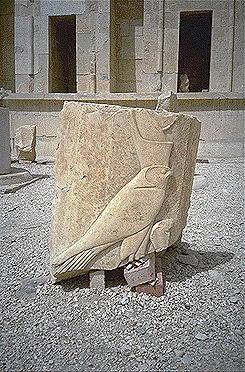
Third Level of Hatshepsut's Mortuary Temple
Among the loose blocks on the third level of Hatshepsut’s mortuary temple is this one decorated with a raised relief carving of Horus as a falcon. He wears the Double Crown of Upper and Lower Egypt, reminding us that the pharaoh was the earthly manifestation of the god, who was ruler of the heavens.
